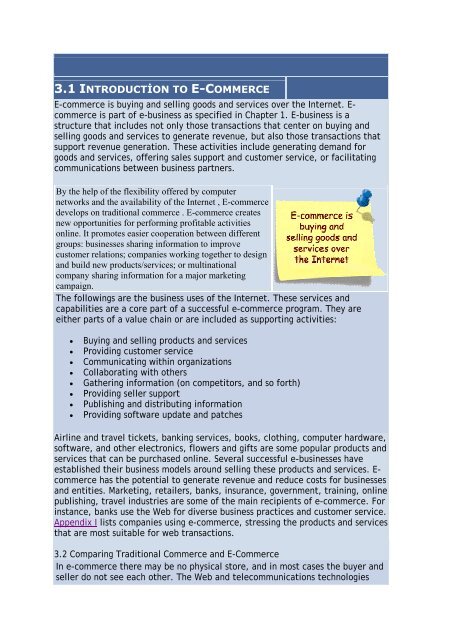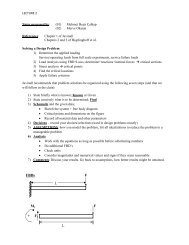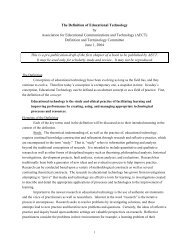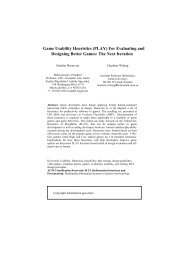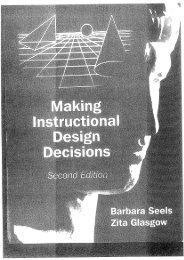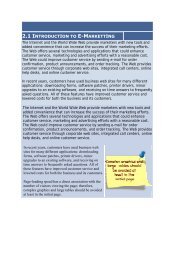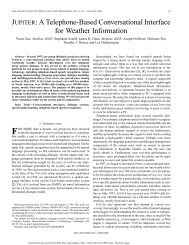3.1 introducti̇on to e-commerce
3.1 introducti̇on to e-commerce
3.1 introducti̇on to e-commerce
You also want an ePaper? Increase the reach of your titles
YUMPU automatically turns print PDFs into web optimized ePapers that Google loves.
<strong>3.1</strong> INTRODUCTİON TO E-COMMERCE<br />
E-<strong>commerce</strong> is buying and selling goods and services over the Internet. E<strong>commerce</strong><br />
is part of e-business as specified in Chapter 1. E-business is a<br />
structure that includes not only those transactions that center on buying and<br />
selling goods and services <strong>to</strong> generate revenue, but also those transactions that<br />
support revenue generation. These activities include generating demand for<br />
goods and services, offering sales support and cus<strong>to</strong>mer service, or facilitating<br />
communications between business partners.<br />
By the help of the flexibility offered by computer<br />
networks and the availability of the Internet , E-<strong>commerce</strong><br />
develops on traditional <strong>commerce</strong> . E-<strong>commerce</strong> creates<br />
new opportunities for performing profitable activities<br />
online. It promotes easier cooperation between different<br />
groups: businesses sharing information <strong>to</strong> improve<br />
cus<strong>to</strong>mer relations; companies working <strong>to</strong>gether <strong>to</strong> design<br />
and build new products/services; or multinational<br />
company sharing information for a major marketing<br />
campaign.<br />
The followings are the business uses of the Internet. These services and<br />
capabilities are a core part of a successful e-<strong>commerce</strong> program. They are<br />
either parts of a value chain or are included as supporting activities:<br />
• Buying and selling products and services<br />
• Providing cus<strong>to</strong>mer service<br />
• Communicating within organizations<br />
• Collaborating with others<br />
• Gathering information (on competi<strong>to</strong>rs, and so forth)<br />
• Providing seller support<br />
• Publishing and distributing information<br />
• Providing software update and patches<br />
Airline and travel tickets, banking services, books, clothing, computer hardware,<br />
software, and other electronics, flowers and gifts are some popular products and<br />
services that can be purchased online. Several successful e-businesses have<br />
established their business models around selling these products and services. E<strong>commerce</strong><br />
has the potential <strong>to</strong> generate revenue and reduce costs for businesses<br />
and entities. Marketing, retailers, banks, insurance, government, training, online<br />
publishing, travel industries are some of the main recipients of e-<strong>commerce</strong>. For<br />
instance, banks use the Web for diverse business practices and cus<strong>to</strong>mer service.<br />
Appendix I lists companies using e-<strong>commerce</strong>, stressing the products and services<br />
that are most suitable for web transactions.<br />
3.2 Comparing Traditional Commerce and E-Commerce<br />
In e-<strong>commerce</strong> there may be no physical s<strong>to</strong>re, and in most cases the buyer and<br />
seller do not see each other. The Web and telecommunications technologies
play a major role, in e-<strong>commerce</strong>. Although the goals and objectives of both e<strong>commerce</strong><br />
and traditional <strong>commerce</strong> are the same—selling products and<br />
services <strong>to</strong> generate profits—they do it quite differently. Traditional <strong>commerce</strong><br />
presents product information by using magazines, flyers. On the other hand, e<strong>commerce</strong><br />
presents by using web sites and online catalogs. Traditional<br />
<strong>commerce</strong> communicates by regular mail, phone yet e-<strong>commerce</strong> by e-mail.<br />
Traditional <strong>commerce</strong> checks product availability by phone, fax and letter.<br />
However, e-<strong>commerce</strong> checks by e-mail, web sites, and internal networks.<br />
Traditional <strong>commerce</strong> generates orders and invoices by printed forms but e<strong>commerce</strong><br />
by e-mail, and web sites. Traditional <strong>commerce</strong> gets product<br />
acknowledgments by phone and fax. On the other hand, e-<strong>commerce</strong> gets by email,<br />
web sites, and EDI.<br />
It is important <strong>to</strong> notice that currently many companies operate with a mix of<br />
traditional and e-<strong>commerce</strong>. Just about all medium and large organizations<br />
have some kind of e-<strong>commerce</strong> presence. The followings are some examples,<br />
Toys-R-Us, Wal-Mart S<strong>to</strong>res, GoldPC, and Vatan Computer.<br />
E-Commerce and Value Chain<br />
Typical business organizations (or parts within a business organization) design ,<br />
produce , market , deliver , and support its product(s)/service(s). Each of these<br />
activities adds cost and value <strong>to</strong> the product/service that is eventually<br />
distributed <strong>to</strong> the cus<strong>to</strong>mer. The value-chain consists of a series of activities<br />
designed <strong>to</strong> satisfy a business need by adding value (or cost) in each phase of the<br />
process. In addition <strong>to</strong> these primary activities that result in a final<br />
product/service, supporting activities in this process also should be included:<br />
• Managing company infrastructure<br />
• Managing human resources<br />
• Obtaining various inputs for each primary activity<br />
• Developing technology <strong>to</strong> keep the business competitive<br />
For instance, in a furniture manufacturing company, the<br />
company buys wood (raw materials) from a logging<br />
company and then converts the wood in<strong>to</strong> chair (finished<br />
product); chairs are shipped <strong>to</strong> retailers, distribu<strong>to</strong>rs, or<br />
cus<strong>to</strong>mers. The company markets and services these chairs<br />
products. Those are the primary activities (value-chain)<br />
that adds value and result in a final product/service for the<br />
company. Value-chain analysis may highlight the<br />
opportunity for the company <strong>to</strong> manufacture products<br />
directly . This means, for furniture manufacturer, it may<br />
enter in the logging business directly or through<br />
partnership with others. The value chain may continue<br />
after delivering chairs <strong>to</strong> the furniture s<strong>to</strong>re. The s<strong>to</strong>re, by<br />
offering other products/services and mixing and matching
this product with other products, may add additional value<br />
<strong>to</strong> the chair.<br />
The Internet can increase the speed and accuracy of communications between<br />
suppliers , distribu<strong>to</strong>rs , and cus<strong>to</strong>mers . Furthermore, the Internet's low cost<br />
allows companies of any size <strong>to</strong> be able <strong>to</strong> take advantage of value-chain<br />
integration. E-<strong>commerce</strong> may improve value chain by identifying new<br />
opportunities for cost reduction . For instance, using e-mail <strong>to</strong> notify cus<strong>to</strong>mers<br />
instead of using regular mail helps for reducing cost . Selling <strong>to</strong> distant<br />
cus<strong>to</strong>mers using the company web site may allow revenue improvement or<br />
generation . These sales may not have been materialized otherwise or selling<br />
digital products such as songs or computer software or distributing software<br />
through the Web. Offering online cus<strong>to</strong>mer service or new sales channel<br />
identification helps for product/service improvement.<br />
Dell Computer generates a large portion of its revenue<br />
through the Web by eliminating the middleman. Cisco<br />
Systems sells much of its networking hardware and<br />
software over the Web, improving revenue and reducing<br />
cost. United Parcel Service (UPS) and Federal Express<br />
use the Internet <strong>to</strong> track packages that result in enhanced<br />
cus<strong>to</strong>mer service<br />
3.4 E-COMMERCE BUSİNESS MODELS<br />
As it is mentioned in Chapter1, the ultimate goal of an e-business is <strong>to</strong> generate<br />
revenue and make a profit, similar <strong>to</strong> traditional businesses. It is factual that the<br />
Internet has improved productivity for almost all the organizations that are using<br />
it. Nevertheless, the bot<strong>to</strong>m line is that productivity must be converted <strong>to</strong><br />
profitability. To achieve profitability as the final goal, different e-businesses or<br />
e-<strong>commerce</strong> sites position themselves in different parts of the value-chain. To<br />
generate revenue, an e-business either sells products/services or shortens the<br />
link between the suppliers and consumers. Many business-<strong>to</strong>-business models try<br />
<strong>to</strong> eliminate the middleman by using the Web <strong>to</strong> deliver products/services<br />
directly <strong>to</strong> their cus<strong>to</strong>mers. By doing this they may be able <strong>to</strong> offer cheaper<br />
products and better cus<strong>to</strong>mer service <strong>to</strong> their cus<strong>to</strong>mers. The end result would<br />
be a differentiation between them and their competi<strong>to</strong>rs, increased market<br />
share, and increased cus<strong>to</strong>mer loyalty. Products sold by e-businesses could be<br />
either traditional products, such as books and clothing, or digital products, such<br />
as songs, computer software, or electronic books.
E-<strong>commerce</strong> models are either an extension or<br />
revision of traditional business models, such as<br />
advertising model, or a new type of business model<br />
that is suitable for the Web implementation, such<br />
as info-mediary. Merchant, brokerage, advertising,<br />
mixed, info-mediary, subscription are the most<br />
popular e-<strong>commerce</strong> models: [2]<br />
• Merchant model: This model b asically transfers the old retail model <strong>to</strong><br />
the e-<strong>commerce</strong> world by using the Internet. There are different types of<br />
merchant models. The most common type of merchant model is similar <strong>to</strong><br />
a traditional business model that sells goods and services over the Web.<br />
Amazon.com is a good example of this type. An e-business similar <strong>to</strong><br />
Amazon.com utilizes the services and technologies offered by the Web <strong>to</strong><br />
sell products and services directly <strong>to</strong> the consumers. By offering good<br />
cus<strong>to</strong>mer service and reasonable prices, these companies establish a<br />
brand on the Web. The merchant model is also used by many traditional<br />
businesses <strong>to</strong> sell goods and services over the Internet. Dell, Cisco<br />
Systems, and Compaq are popular examples. These companies eliminate<br />
the middleman by generating a portion of their <strong>to</strong>tal sale over the Web<br />
and by accessing difficult-<strong>to</strong>-reach cus<strong>to</strong>mers. An example that uses this<br />
model is Amazon.com Corporation. [ Appendix II ]<br />
• Brokerage model: T he e-business brings the sellers and buyers <strong>to</strong>gether<br />
on the Web and collects a commission on the transactions by using this<br />
model. The best example of this type is an online auction site such as<br />
eBay, gittigidiyor.com which can generate additional revenue by selling<br />
banner advertisement on their sites.<br />
• Advertising model: This model is an extension of traditional advertising<br />
media, such as television and radio. Search engines and direc<strong>to</strong>ries such<br />
as Google and Yahoo provide contents (similar <strong>to</strong> radio and TV) and allow<br />
the users <strong>to</strong> access this content for free. By creating significant traffic,<br />
these e-businesses are able <strong>to</strong> charge advertisers for putting banner ads<br />
or leasing spots on their sites.<br />
• Mixed model: This model generates revenue both from advertising and<br />
subscriptions. Internet service providers (ISPs) such as America On-line<br />
(AOL), and SuperOnline generate revenue from advertising and their<br />
cus<strong>to</strong>mers' subscription fees for Internet access.<br />
• Info-mediary model: E-businesses that use this model collect information<br />
on consumers and businesses and then sell this information <strong>to</strong> interested<br />
parties for marketing purposes. For instance, bizrate.com collect<br />
information related <strong>to</strong> the performance of other sites and sells this<br />
information <strong>to</strong> advertisers. Netzero.com provides free Internet access; in
ehavior of cus<strong>to</strong>mers. This information is later sold <strong>to</strong> advertisers for<br />
direct marketing. eMachines.com offers free PCs <strong>to</strong> its cus<strong>to</strong>mers for the<br />
same purpose.<br />
• Subscription model: An e-business might sell digital products <strong>to</strong> its<br />
cus<strong>to</strong>mers, by using this model. The Wall Street Journal and Consumer<br />
Reports are two examples. Sreeet.com, AjansPress.com is another<br />
example of this model that sells business news and analysis based on<br />
subscription.<br />
3.4 MAJOR TYPES OF E-COMMERCE<br />
The several types of e-<strong>commerce</strong> in use <strong>to</strong>day are classified based on the nature of<br />
the transactions: business-<strong>to</strong>-consumer (B2C), business-<strong>to</strong>-business (B2B),<br />
consumer-<strong>to</strong>-consumer (C2C), consumer-<strong>to</strong>-business (C2B), and non-business and<br />
government, and organizational (intra-business).<br />
3.4.1 BUSINESS-TO-CONSUMER E-COMMERCE<br />
In B2C e-<strong>commerce</strong>, businesses sell directly a diverse group of products and<br />
services <strong>to</strong> cus<strong>to</strong>mers . In addition <strong>to</strong> pure B2C e-<strong>commerce</strong> players such as<br />
Amazon.com, and hepsiburada.com other traditional businesses have entered the<br />
virtual marketplace by establishing comprehensive web sites and virtual<br />
s<strong>to</strong>refronts. In these cases, e-<strong>commerce</strong> supplements the traditional <strong>commerce</strong> by<br />
offering products and services through electronic channels. Wal-Mart S<strong>to</strong>res, and<br />
the Gap are examples of companies that are very active in B2C e-<strong>commerce</strong>. Some<br />
of the advantages of these e-<strong>commerce</strong> sites and companies include availability of<br />
physical space (cus<strong>to</strong>mers can physically visit the s<strong>to</strong>re), availability of returns<br />
(cus<strong>to</strong>mers can return a purchased item <strong>to</strong> the physical s<strong>to</strong>re), and availability of<br />
cus<strong>to</strong>mer service in these physical s<strong>to</strong>res. Figure <strong>3.1</strong> illustrates a B2C relationship.<br />
In the figure ISP, means Internet service provider.
Figure <strong>3.1</strong> A business-<strong>to</strong>-consumer (B2C) e-<strong>commerce</strong> relationship<br />
A Business-<strong>to</strong>-Consumer e-Commerce Cycle<br />
There are five major activities involved in conducting B2C e-<strong>commerce</strong>. The B2B e<strong>commerce</strong><br />
model uses a similar cycle, as shown in Figure 3.2.<br />
Figure 3.2 Major activities for B2C e-<strong>commerce</strong>.<br />
1. Info sharing: A B2C e-<strong>commerce</strong> may use some or all of the following<br />
applications and technologies <strong>to</strong> share information with cus<strong>to</strong>mers: Online<br />
advertisements, e-mail, newsgroups/discussion groups, company web site,<br />
online catalogs, message board systems, bulletin board systems, multiparty<br />
conferencing.<br />
2. Ordering: A cus<strong>to</strong>mer may use electronic e-mail or forms available on the<br />
company's web site <strong>to</strong> order a product from a B2C site. A mouse click sends<br />
the essential information relating <strong>to</strong> the requested piece(s) <strong>to</strong> the B2C site.<br />
3. Payment: Credit cards, electronic checks, and digital cash are among the<br />
popular options that the cus<strong>to</strong>mer has as options for paying for the goods or<br />
services.<br />
4. Fulfillment. F ulfillment that is responsible for physically delivering the<br />
product or service from the merchant <strong>to</strong> the cus<strong>to</strong>mer. In case of physical<br />
products(books, videos, CDs), the filled order can be sent <strong>to</strong> the cus<strong>to</strong>mer<br />
using regular mail, MNG, Yurtiçi Cargo, FedEx, or UPS. As expected for<br />
faster delivery, the cus<strong>to</strong>mer has <strong>to</strong> pay additional money. In case of digital<br />
products (software, music, electronic documents), the e-business uses<br />
digital documentations <strong>to</strong> assure security, integrity, and privacy of the<br />
product. It may also include delivery address verification and digital<br />
warehousing that s<strong>to</strong>res digital products on a computer until they are<br />
delivered. The e-business can handle its own fulfillment operations or outsource<br />
this function <strong>to</strong> third parties with moderate costs.<br />
5. Service and support: It is much cheaper <strong>to</strong> maintain current cus<strong>to</strong>mers<br />
than <strong>to</strong> attract new cus<strong>to</strong>mers. For this reason, e-businesses should do
whatever that they can in order <strong>to</strong> provide timely, high-quality service and<br />
support <strong>to</strong> their cus<strong>to</strong>mers. As e-<strong>commerce</strong> companies lack a traditional<br />
physical presence and need other ways <strong>to</strong> maintain current cus<strong>to</strong>mers,<br />
service and support are even more important in e-<strong>commerce</strong> than<br />
traditional businesses. The following are some examples of technologies<br />
and applications used for providing service and support: (E-mail<br />
confirmation, periodic news flash, and online surveys may also be used as<br />
marketing <strong>to</strong>ols.)<br />
o E-mail confirmation: In most cases, the e-mail confirmation<br />
provides the cus<strong>to</strong>mer with a confirmation number that the cus<strong>to</strong>mer<br />
can use <strong>to</strong> trace the product or service. E-mail confirmation promises<br />
the cus<strong>to</strong>mer that a particular order has been processed and that the<br />
cus<strong>to</strong>mer should receive the product/ service by a certain date.<br />
o Periodic news flash: They used <strong>to</strong> give cus<strong>to</strong>mers with the latest<br />
information on the company or on a particular product or offering.<br />
o Online Surveys: Their results can assist the e-<strong>commerce</strong> site <strong>to</strong><br />
provide better services and support <strong>to</strong> its cus<strong>to</strong>mers based on what<br />
has been collected in the survey, even though online surveys are<br />
mostly used as a marketing <strong>to</strong>ol.<br />
o Help desks: They provide answers <strong>to</strong> common problems or provide<br />
advice for using products or services. They are used for the same<br />
purpose as in traditional businesses.<br />
o Assured secure transactions & assured online auctions: They<br />
guarantee cus<strong>to</strong>mers that the e-<strong>commerce</strong> site covers all the security<br />
and privacy issues. As many cus<strong>to</strong>mers still do not feel comfortable<br />
conducting online business, the security and privacy services are<br />
especially important.<br />
Business-<strong>to</strong>-Business e-Commerce<br />
Business-<strong>to</strong>-Business e-<strong>commerce</strong> holds electronic transactions among and between<br />
businesses. The Internet and reliance of all businesses upon other companies for<br />
supplies, utilities, and services has enhanced the popularity of B2B e-<strong>commerce</strong><br />
and made B2B the fastest growing segment within the e-<strong>commerce</strong> environment. In<br />
recent years extranets (more than one intranet) have been effectively used for B2B<br />
operations. B2B e-<strong>commerce</strong> creates dynamic interaction among the business<br />
partners; this represents a fundamental shift in how business will be conducted in<br />
the 21st century.<br />
Oracle, PeopleSoft, SAP, Broadvision, Commerce One, Heatheon/Webmd, 12<br />
Technologies, Inc., Ariba , Aspect Development, Baan, BEA Systems, Internet<br />
Capital Group, VerticalNet, Vignette are some of the major vendors of e-<strong>commerce</strong><br />
and B2B solutions [1].<br />
Companies using B2B e-<strong>commerce</strong> relationship observe cost savings by increasing<br />
the speed, reducing errors, and eliminating many manual activities. Wal-Mart<br />
S<strong>to</strong>res is an example for B2B e-<strong>commerce</strong>. Wal-Mart's major suppliers (e.g., Proc<strong>to</strong>r<br />
& Gamble, Johnson and Johnson, and others) sell <strong>to</strong> Wal-Mart S<strong>to</strong>res electronically;
all the paperwork is handled electronically. These suppliers can access online the<br />
inven<strong>to</strong>ry status in each s<strong>to</strong>re and refill needed products in a timely manner. In a<br />
B2B environment, purchase orders, invoices, inven<strong>to</strong>ry status, shipping logistics,<br />
and business contracts handled directly through the network result in increased<br />
speed, reduced errors, and cost savings.[4] B2B e-<strong>commerce</strong> reduces cycle time,<br />
inven<strong>to</strong>ry, and prices and enables business partners <strong>to</strong> share relevant, accurate,<br />
and timely information. The end result is improved supply-chain management<br />
among business partners [5]. The following figure illustrates a generic B2B<br />
relationship. (Figure 3.2)<br />
Figure 3.3 A business-<strong>to</strong>-business (B2B) e-<strong>commerce</strong> relationship<br />
The following paragraphs provide brief descriptions of the advantages of B2B e<strong>commerce</strong>:<br />
• A B2B e-<strong>commerce</strong> lowers production cost by eliminating many labor-<br />
intensive tasks.<br />
• More timely information is achieved by the formation of a direct online<br />
connection in the supply chain.<br />
• Accuracy is increased because fewer manual steps are involved.<br />
• Cycle time improves because flow of information and products between<br />
business partners is made simpler. Since, raw materials are received faster<br />
and information related <strong>to</strong> cus<strong>to</strong>mer demands is more quickly transferred.
• Naturally this close communication between the business partners improves<br />
overall communication .<br />
• Increased communications results in improved inven<strong>to</strong>ry management and<br />
control.<br />
Major Models of Business-<strong>to</strong>-Business e-Commerce<br />
The three major B2B e-<strong>commerce</strong> models are determined by seller, buyer, or<br />
intermediary (third party) who controls the marketplace. Consequently, the<br />
following four marketplaces have been created. Each model has specific<br />
characteristics and is suitable for a specific business:<br />
• Seller-controlled marketplace: This is t he most popular type of B2B model<br />
for both consumers and businesses. In this model the sellers who provide <strong>to</strong><br />
fragmented markets such as chemicals, electronics, and au<strong>to</strong> components<br />
come <strong>to</strong>gether <strong>to</strong> generate a common trading place for the buyers. While<br />
the sellers aggregate their market power, it simplifies the buyers search for<br />
alternative sources. Businesses and some time consumers use the seller's<br />
product catalog <strong>to</strong> order products and services online.<br />
One popular application of this model is e-procurement , which significantly<br />
streamlines the traditional procurement process by using the Internet and web<br />
technologies. E-procurement is radically changing the buying process by allowing<br />
employees throughout the organization <strong>to</strong> order and receive supplies/services<br />
from their desk<strong>to</strong>p with just a few mouse clicks. This results in major cost savings<br />
and improves the timeliness of procurement processes and the strategic alliances<br />
between suppliers and participating organizations. E-procurement may qualify<br />
cus<strong>to</strong>mers for volume discounts or special offers. E-procurement software may<br />
make it possible <strong>to</strong> au<strong>to</strong>mate some buying and selling, resulting in reduced costs<br />
and improved processing speeds. The participating companies expect <strong>to</strong> be able <strong>to</strong><br />
control inven<strong>to</strong>ries more effectively, reduce purchasing-agent overhead, and<br />
improve manufacturing cycles. E-procurement is expected <strong>to</strong> be integrated in<strong>to</strong><br />
standard business systems with the trend <strong>to</strong>ward computerized supply-chain<br />
management.<br />
• Buyer-controlled marketplace: This model is used by large companies with<br />
significant buying power or a consortium of several large companies. The<br />
consortium among Ford, General Mo<strong>to</strong>rs and Daimler Chrysler is a good<br />
example of this model. In this model a buyer or a group of buyers opens an<br />
electronic marketplace and invites sellers <strong>to</strong> bid on the announced products<br />
or RFQs (request for quotation). Using this model the buyers are looking <strong>to</strong><br />
efficiently manage the procurement process, lower administrative cost, and<br />
exercise uniform pricing. Companies are making investments in a buyercontrolled<br />
marketplace with the goal of establishing new sales channels<br />
that increase market presence and lower the cost of each sale. By<br />
participating in a buyer-controlled marketplace a seller could perform the<br />
following:<br />
o Get better understanding of buying behaviors<br />
o Carry out pre-sales marketing
o Carry out sales transactions<br />
o Carry out post-sales analysis<br />
o Reduce order placement and delivery cycle time<br />
o Offer an alternative sales channel<br />
o Au<strong>to</strong>mate the order management process<br />
o Au<strong>to</strong>mate the fulfillment process<br />
• Third-party exchanges marketplace: A third-party-controlled marketplace<br />
model is controlled by a third party not by sellers or buyers. A third-partycontrolled<br />
marketplace model offers suppliers a direct channel of<br />
communication <strong>to</strong> buyers through online s<strong>to</strong>refronts. The interactive<br />
procedures within the marketplace contain features like product catalogs,<br />
request for information (RFI), rebates and promotions, broker contacts, and<br />
product sample requests. The marketplace makes revenue from the fees<br />
generated by matching buyers and sellers. These marketplaces are usually<br />
active either in a vertical or horizontal market .<br />
A vertical market focuses on a specific industry or market. The following are some<br />
examples of this type: PaperExchange.com (supplies for publishers),<br />
PlasticsNet.com (raw materials and equipment), SciQuest.com (labora<strong>to</strong>ry<br />
products), VerticalNet.com (Provide end-<strong>to</strong>-end e-<strong>commerce</strong> solutions that arc<br />
targeted at distinct business segments)<br />
A horizontal market concentrates on a specific function or business process. They<br />
provide the same function or au<strong>to</strong>mate the same business process across different<br />
industries. The following are some examples: Employee.com (employee benefits<br />
administration), CtSpace.com ( web-based collaboration, business process<br />
management and document management solutions)<br />
• Trading partner agreements: The main objectives of the trading partner<br />
agreements B2B e-<strong>commerce</strong> model are <strong>to</strong> au<strong>to</strong>mate the processes for<br />
negotiating and enforcing contracts between participating businesses. This<br />
relatively new model is gaining popularity. This model is expected <strong>to</strong><br />
become more common as extensible markup language (XML) and the ebusiness<br />
XML initiative (ebXML) become more accepted. This worldwide<br />
project is attempting <strong>to</strong> standardize the exchange of e-business data via<br />
XML, including electronic contracts and trading partner agreements. Using<br />
this model enables cus<strong>to</strong>mers <strong>to</strong> submit electronic documents that<br />
previously required hard-copy signatures via the Internet. As soon as act<br />
passed by the Turkish Governmet that gives digital signatures the same<br />
legal validity as handwritten signatures, this model will also be very popular<br />
in Turkey <strong>to</strong>o.<br />
The main advantage of XML (extensible markup language) over hypertext markup<br />
language (HTML) is that it can assign data type definitions <strong>to</strong> all the data included<br />
in a page. This allows the Internet browser <strong>to</strong> select only the data requested in<br />
any given search, leading <strong>to</strong> ease of data transfer and readability because only the<br />
suitable data are transferred. This may be particularly useful in m-<strong>commerce</strong><br />
(mobile <strong>commerce</strong>); XML loads only needed data <strong>to</strong> the browser, resulting in more<br />
efficient and effective searches. This would significantly lower traffic on the
Internet and speed up delay times during peak hours. XML-based B2B trading<br />
partner agreements configurations can be business contracts, shipping logistics,<br />
inven<strong>to</strong>ry status or purchase order , for example.<br />
3.4.2 BUSİNESS-TO-BUSİNESS E-<br />
COMMERCE<br />
ABusiness-<strong>to</strong>-Business e-<strong>commerce</strong> holds electronic transactions among and<br />
between businesses. The Internet and reliance of all businesses upon other<br />
companies for supplies, utilities, and services has enhanced the popularity of B2B<br />
e-<strong>commerce</strong> and made B2B the fastest growing segment within the e-<strong>commerce</strong><br />
environment. In recent years extranets (more than one intranet) have been<br />
effectively used for B2B operations. B2B e-<strong>commerce</strong> creates dynamic interaction<br />
among the business partners; this represents a fundamental shift in how business<br />
will be conducted in the 21st century.<br />
Oracle, PeopleSoft, SAP, Broadvision, Commerce One, Heatheon/Webmd, 12<br />
Technologies, Inc., Ariba , Aspect Development, Baan, BEA Systems, Internet<br />
Capital Group, VerticalNet, Vignette are some of the major vendors of e-<strong>commerce</strong><br />
and B2B solutions [1].<br />
Companies using B2B e-<strong>commerce</strong> relationship observe cost savings by increasing<br />
the speed, reducing errors, and eliminating many manual activities. Wal-Mart<br />
S<strong>to</strong>res is an example for B2B e-<strong>commerce</strong>. Wal-Mart's major suppliers (e.g., Proc<strong>to</strong>r<br />
& Gamble, Johnson and Johnson, and others) sell <strong>to</strong> Wal-Mart S<strong>to</strong>res electronically;<br />
all the paperwork is handled electronically. These suppliers can access online the<br />
inven<strong>to</strong>ry status in each s<strong>to</strong>re and refill needed products in a timely manner. In a<br />
B2B environment, purchase orders, invoices, inven<strong>to</strong>ry status, shipping logistics,<br />
and business contracts handled directly through the network result in increased<br />
speed, reduced errors, and cost savings.[4] B2B e-<strong>commerce</strong> reduces cycle time,<br />
inven<strong>to</strong>ry, and prices and enables business partners <strong>to</strong> share relevant, accurate,<br />
and timely information. The end result is improved supply-chain management<br />
among business partners [5]. The following figure illustrates a generic B2B<br />
relationship. (Figure 3.2)
Figure 3.3 A business-<strong>to</strong>-business (B2B) e-<strong>commerce</strong> relationship<br />
The following paragraphs provide brief descriptions of the advantages of B2B e<strong>commerce</strong>:<br />
• A B2B e-<strong>commerce</strong> lowers production cost by eliminating many labor-<br />
intensive tasks.<br />
• More timely information is achieved by the formation of a direct online<br />
connection in the supply chain.<br />
• Accuracy is increased because fewer manual steps are involved.<br />
• Cycle time improves because flow of information and products between<br />
business partners is made simpler. Since, raw materials are received faster<br />
and information related <strong>to</strong> cus<strong>to</strong>mer demands is more quickly transferred.<br />
• Naturally this close communication between the business partners improves<br />
overall communication .<br />
• Increased communications results in improved inven<strong>to</strong>ry management and<br />
control.<br />
Major Models of Business-<strong>to</strong>-Business e-Commerce<br />
The three major B2B e-<strong>commerce</strong> models are determined by seller, buyer, or<br />
intermediary (third party) who controls the marketplace. Consequently, the<br />
following four marketplaces have been created. Each model has specific
characteristics and is suitable for a specific business:<br />
• Seller-controlled marketplace: This is t he most popular type of B2B model<br />
for both consumers and businesses. In this model the sellers who provide <strong>to</strong><br />
fragmented markets such as chemicals, electronics, and au<strong>to</strong> components<br />
come <strong>to</strong>gether <strong>to</strong> generate a common trading place for the buyers. While<br />
the sellers aggregate their market power, it simplifies the buyers search for<br />
alternative sources. Businesses and some time consumers use the seller's<br />
product catalog <strong>to</strong> order products and services online.<br />
One popular application of this model is e-procurement , which significantly<br />
streamlines the traditional procurement process by using the Internet and web<br />
technologies. E-procurement is radically changing the buying process by allowing<br />
employees throughout the organization <strong>to</strong> order and receive supplies/services<br />
from their desk<strong>to</strong>p with just a few mouse clicks. This results in major cost savings<br />
and improves the timeliness of procurement processes and the strategic alliances<br />
between suppliers and participating organizations. E-procurement may qualify<br />
cus<strong>to</strong>mers for volume discounts or special offers. E-procurement software may<br />
make it possible <strong>to</strong> au<strong>to</strong>mate some buying and selling, resulting in reduced costs<br />
and improved processing speeds. The participating companies expect <strong>to</strong> be able <strong>to</strong><br />
control inven<strong>to</strong>ries more effectively, reduce purchasing-agent overhead, and<br />
improve manufacturing cycles. E-procurement is expected <strong>to</strong> be integrated in<strong>to</strong><br />
standard business systems with the trend <strong>to</strong>ward computerized supply-chain<br />
management.<br />
• Buyer-controlled marketplace: This model is used by large companies with<br />
significant buying power or a consortium of several large companies. The<br />
consortium among Ford, General Mo<strong>to</strong>rs and Daimler Chrysler is a good<br />
example of this model. In this model a buyer or a group of buyers opens an<br />
electronic marketplace and invites sellers <strong>to</strong> bid on the announced products<br />
or RFQs (request for quotation). Using this model the buyers are looking <strong>to</strong><br />
efficiently manage the procurement process, lower administrative cost, and<br />
exercise uniform pricing. Companies are making investments in a buyercontrolled<br />
marketplace with the goal of establishing new sales channels that<br />
increase market presence and lower the cost of each sale. By participating<br />
in a buyer-controlled marketplace a seller could perform the following:<br />
o Get better understanding of buying behaviors<br />
o Carry out pre-sales marketing<br />
o Carry out sales transactions<br />
o Carry out post-sales analysis<br />
o Reduce order placement and delivery cycle time<br />
o Offer an alternative sales channel<br />
o Au<strong>to</strong>mate the order management process<br />
o Au<strong>to</strong>mate the fulfillment process<br />
• Third-party exchanges marketplace: A third-party-controlled marketplace<br />
model is controlled by a third party not by sellers or buyers. A third-partycontrolled<br />
marketplace model offers suppliers a direct channel of<br />
communication <strong>to</strong> buyers through online s<strong>to</strong>refronts. The interactive<br />
procedures within the marketplace contain features like product catalogs,
equest for information (RFI), rebates and promotions, broker contacts, and<br />
product sample requests. The marketplace makes revenue from the fees<br />
generated by matching buyers and sellers. These marketplaces are usually<br />
active either in a vertical or horizontal market .<br />
A vertical market focuses on a specific industry or market. The following are some<br />
examples of this type: PaperExchange.com (supplies for publishers),<br />
PlasticsNet.com (raw materials and equipment), SciQuest.com (labora<strong>to</strong>ry<br />
products), VerticalNet.com (Provide end-<strong>to</strong>-end e-<strong>commerce</strong> solutions that arc<br />
targeted at distinct business segments)<br />
A horizontal market concentrates on a specific function or business process. They<br />
provide the same function or au<strong>to</strong>mate the same business process across different<br />
industries. The following are some examples: Employee.com (employee benefits<br />
administration), CtSpace.com ( web-based collaboration, business process<br />
management and document management solutions)<br />
• Trading partner agreements: The main objectives of the trading partner<br />
agreements B2B e-<strong>commerce</strong> model are <strong>to</strong> au<strong>to</strong>mate the processes for<br />
negotiating and enforcing contracts between participating businesses. This<br />
relatively new model is gaining popularity. This model is expected <strong>to</strong><br />
become more common as extensible markup language (XML) and the ebusiness<br />
XML initiative (ebXML) become more accepted. This worldwide<br />
project is attempting <strong>to</strong> standardize the exchange of e-business data via<br />
XML, including electronic contracts and trading partner agreements. Using<br />
this model enables cus<strong>to</strong>mers <strong>to</strong> submit electronic documents that<br />
previously required hard-copy signatures via the Internet. As soon as act<br />
passed by the Turkish Governmet that gives digital signatures the same<br />
legal validity as handwritten signatures, this model will also be very popular<br />
in Turkey <strong>to</strong>o.<br />
The main advantage of XML (extensible markup language) over hypertext markup<br />
language (HTML) is that it can assign data type definitions <strong>to</strong> all the data included<br />
in a page. This allows the Internet browser <strong>to</strong> select only the data requested in<br />
any given search, leading <strong>to</strong> ease of data transfer and readability because only the<br />
suitable data are transferred. This may be particularly useful in m-<strong>commerce</strong><br />
(mobile <strong>commerce</strong>); XML loads only needed data <strong>to</strong> the browser, resulting in more<br />
efficient and effective searches. This would significantly lower traffic on the<br />
Internet and speed up delay times during peak hours. XML-based B2B trading<br />
partner agreements configurations can be business contracts, shipping logistics,<br />
inven<strong>to</strong>ry status or purchase order , for example.<br />
3.4.3 CONSUMER-TO-CONSUMER E-<br />
COMMERCE
Using C2C e-<strong>commerce</strong>, consumers sell directly <strong>to</strong> other consumers using the Internet and<br />
web technologies. Individuals sell a wide variety of services/products on the Web or<br />
through auction sites such as eBay.com, and gittigidiyor.com through classified ads or by<br />
advertising. Figure 3.3 illustrates a general C2C e-<strong>commerce</strong> relationship. Consumers are<br />
also able <strong>to</strong> advertise their products and services in organizational intranets and sell them<br />
<strong>to</strong> other employees.<br />
Figure 3.4 A consumer-<strong>to</strong>-consumer (C2C) e-<strong>commerce</strong> relationship<br />
3.4.4 CONSUMER-TO-BUSINESS E-COMMERCE<br />
Consumer-<strong>to</strong>-business (C2B) e-<strong>commerce</strong> that involves individuals selling <strong>to</strong><br />
businesses may include a service/product that a consumer is willing <strong>to</strong> sell.<br />
Individuals offer certain prices for specific products/services. Companies such as<br />
pazaryerim.com and mobshop.com are examples of C2B. Figure 2-4 shows a C2B<br />
e-<strong>commerce</strong> relationship.
Figure 3.5 A consumer-<strong>to</strong>-business (C2B) e-<strong>commerce</strong> relationship<br />
3.4.5 NON-BUSINESS AND GOVERNMENT E-COMMERCE<br />
Political, social and not-for-profit organizations also use e-<strong>commerce</strong> applications<br />
for various activities, such as fundraising and political forums. These<br />
organizations also use e-<strong>commerce</strong> for cus<strong>to</strong>mer service and for purchasing <strong>to</strong><br />
decrease cost and get better speed. Universities are using e-<strong>commerce</strong><br />
applications extensively for delivering their educational products and services on<br />
a global scale. The e-<strong>commerce</strong> applications in government and many nonbusiness<br />
organizations are on the rise.<br />
3.4.6 INTRA-BUSINESS E-COMMERCE<br />
The organization intranets provide the right platform for intra-business e<strong>commerce</strong>.<br />
Intra-business e-<strong>commerce</strong> involves all the e-<strong>commerce</strong>-related<br />
activities that take place within the organization. These activities may include<br />
exchange of information, goods, or services among the employees of an<br />
organization. This may include selling organization products/services <strong>to</strong> the<br />
employees, offering human resources services, conducting training programs, and<br />
much more.<br />
3.7 VOİCE-BASED E-COMMERCE
Now days, just picking up a phone and accessing a web site you can order a<br />
product. At the core of these new services are voice recognition and text-<strong>to</strong>speech<br />
technologies that have improved significantly during the past decades.<br />
Cus<strong>to</strong>mers will be able <strong>to</strong> speak the name of the web site or service they want <strong>to</strong><br />
access and the system will recognize the command and respond with spoken<br />
words. By using voice commands, consumers soon will be able <strong>to</strong> search a<br />
database by product name and locate the merchant with the most competitive<br />
prices.<br />
One method <strong>to</strong> conduct voice-based e-<strong>commerce</strong> is <strong>to</strong> use digital wallets (ewallets)<br />
online. In addition <strong>to</strong> financial information these wallets include other<br />
related information, such as the cus<strong>to</strong>mer's address, billing information, driver's<br />
license, and so forth. This information can be conveniently transferred online.<br />
Digital wallets are created through the cus<strong>to</strong>mers' PCs and used for voice-based<br />
e-<strong>commerce</strong> transactions. Security features for voice-based e-<strong>commerce</strong> are<br />
expected <strong>to</strong> include the following: Voice recognition, so that authorizations have<br />
<strong>to</strong> match a specific voice, call recognition, so that calls have <strong>to</strong> be placed from<br />
specific mobile devices. Voice-based e-<strong>commerce</strong> will be suitable for applications<br />
such as the following: Receiving sports scores, finding directions <strong>to</strong> a new<br />
restaurant, reserving tickets for local movies, buying a book.<br />
There are already several voice portals on the market. The following are among<br />
the popular ones: InternetSpeech.com (Figure 3.5), BeVocal.com, Tellme.com.<br />
Figure 3.5 The initial screen of InternetSpeech.com
Appendix I<br />
Some Companies Using e-Commerce [1]<br />
Amazon.com provides access <strong>to</strong> books music CDs, electronics, software, <strong>to</strong>ys, video games,<br />
prescription drugs, and much more electronically. www.amazon.com<br />
American Express successfully uses e-<strong>commerce</strong> for credit card transactions. www.<br />
americanexpress .com<br />
Apple Computer sells computers online. www.apple.com<br />
Au<strong>to</strong>-by-Tel sells cars over the Web. www.au<strong>to</strong>bytel.com<br />
Cisco Systems sells data communications components over the Web. www. cisco .com<br />
Dell Computer and Gateway sell computers through their web sites and allow cus<strong>to</strong>mers <strong>to</strong><br />
configure their systems on the Web and then purchase them. www. dell .com , www. gateway<br />
.com<br />
Drugs<strong>to</strong>re.com and CVS.com refill and sell new drugs and vitamins and other health and<br />
beauty products online. www. drugs<strong>to</strong>re . com , www.cvs.com<br />
Epicurious sells exotic foods over the Web. www. epicurious .com<br />
Peapod sells groceries over the Web. www. peapod .com<br />
Proc<strong>to</strong>r & Gamble and IBM conduct order placements electronically. www.pg.com , www.<br />
ibm .com<br />
Appendix II<br />
Industry Connection: Amazon.Com Corporation [1]<br />
Amazon.com is one of the leaders in B2C e-<strong>commerce</strong>. Amazon.com opened its virtual s<strong>to</strong>res<br />
in July 1995 with a mission <strong>to</strong> use the Internet <strong>to</strong> transform book buying in<strong>to</strong> the fastest and<br />
easiest shopping experience possible. Amazon.com offers numerous products and services<br />
including books, CDs, videos, DVDs. <strong>to</strong>ys, games, electronics, free electronic greeting cards,<br />
online auctions, and much more. In addition <strong>to</strong> an extensive catalog of products, Amazon.com<br />
offers a wide variety of other shopping services and partnership opportunities.<br />
Amazon.com's business model is based on the merchant model . By creating cus<strong>to</strong>mer<br />
accounts, using shopping carts, and using the 1-click technology, Amazon.com makes the<br />
shopping experience fast and convenient. E-mail is used for order confirmation and cus<strong>to</strong>mer
notification when new products that suit a particular cus<strong>to</strong>mer become available. Allowing<br />
cus<strong>to</strong>mers <strong>to</strong> post their own book reviews, creates an open forum between the s<strong>to</strong>refront and<br />
its cus<strong>to</strong>mers. Using Amazon.com a prospective shopper can do the following:<br />
• Search for books, music, and many other products and services<br />
• Browse virtual aisles in hundreds of product categories from audio books, jazz, and<br />
video documentaries <strong>to</strong> coins and stamps available for auction.<br />
• Get instant personalized recommendations based on the shopper's prior purchases as<br />
soon as the shopper logs on.<br />
• Sign up for the Amazon.com e-mail subscription service <strong>to</strong> receive the latest reviews<br />
of new titles in categories that interest the cus<strong>to</strong>mer.<br />
• Amazon.com offers a safe and secure shopping experience by guaranteeing its<br />
shopping and auction services. It also offers 24-hour-a-day, 7-days-a-week help desk<br />
services <strong>to</strong> assist shoppers who experience difficulties.


